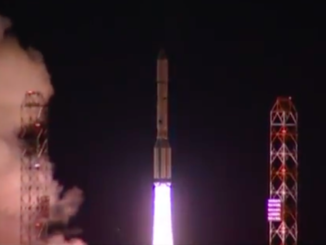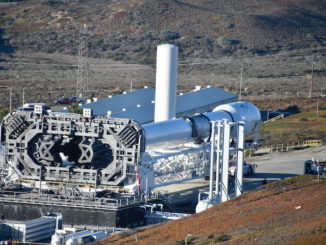
NASA and Northrop Grumman managers at the Kennedy Space Center decided Tuesday to press ahead with final preparations to launch a NASA scientific research satellite early Wednesday aboard an air-launched Pegasus XL rocket off Florida’s east coast.
Officials confirmed Wednesday’s planned launch attempt during a launch readiness review Tuesday morning, and teams planned to take Tuesday afternoon to rest up ahead of an overnight countdown.
There is a 90-minute window Wednesday to launch NASA’s Ionospheric Connection Explorer, or ICON, satellite aboard an air-dropped Northrop Grumman Pegasus XL rocket. The window opens at 3 a.m. EST (0800 GMT), with release of the 57-foot-long (17-meter) rocket from an L-1011 carrier aircraft planned at 3:05 a.m. EST (0805 GMT) around 100 miles (160 kilometers) east of Daytona Beach.
A point of discussion during Tuesday’s launch readiness review was the readiness of a GPS navigation receiver on the Pegasus rocket. The navigation receiver feeds position data from GPS satellites to the rocket’s guidance computer before ignition, providing information on the exact location of the launcher after release from the L-1011 carrier aircraft and before it fires into orbit.
The Pegasus rocket’s GPS receiver displayed an error indication during the L-1011’s cross-country ferry flight to Cape Canaveral on Oct. 19 from Vandenberg Air Force Base in California, where Northrop Grumman assembles the air-dropped booster.
Technicians replaced hardware on the rocket and conducted a nearly five-hour test flight on Oct. 28. Engineers followed these test flight with a series of data reviews to assess the health of the GPS receiver, which continued providing good position data despite giving controllers an error indication. The GPS receiver is not used during the powered portion of the Pegasus launch.
If the GPS system suffers another problem during Wednesday’s flight to the drop box, NASA plans to abort the mission and call the L-1011 back to Cape Canaveral for further analysis and troubleshooting, officials said.
The GPS receiver issue delayed ICON’s launch from Oct. 26, the latest of several schedule slips due to rocket concerns. ICON was supposed to launch in June 2017, but the mission was delayed after the mishandling of Pegasus rocket stages during transport to the Vandenberg integration site, followed by a months-long evaluation of the reliability of bolt-cutters used to jettison the Pegasus payload fairing and separate the satellite in orbit.
With those issues resolved, engineers noticed an unexpected telemetry signal from the rocket’s rudder fin actuator after the L-1011’s departure June 6 from Vandenberg on a two-day ferry flight to Kwajalein Atoll in the Marshall Islands, ICON’s original launch base.
Officials ordered the rocket to return to Vandenberg for inspections and testing, and NASA decided to move the launch to a location off the Florida coast, which offered more launch opportunities through the Eastern Range operated by the U.S. Air Force’s 45th Space Wing.
Kwajalein is home of the U.S. Army’s Reagan Test Site, a range often busy with military missile tests, with few openings for a civilian launch.
ICON ended up weighing a little less than originally designed, allowing managers to relocate the launch from near the equator over the Pacific Ocean to the Atlantic Ocean off Florida’s east coast. With ICON’s lower mass, the Pegasus has the ability to boost the satellite into the correct orbit without requiring a launch base so close to the equator.
Thomas Immel, ICON’s principal investigator at the University of California, Berkeley, said he was relieved the mission appears ready to finally go into space.
“After all the concern and the difficulty with the components of the rocket, it’s a great relief,” Immel told Spaceflight Now on Tuesday afternoon. “It feels pretty great to NASA’s approval to fly, so I’m really looking forward to it. A few hundred seconds, and we’re going to be on orbit, and it’s going to be fantastic.”
The solid-fueled Pegasus XL rocket will release ICON from its third stage at T+plus 11 minutes, 20 seconds. ICON will start extending its power-generating solar panels less than two minutes after deployment from the Pegasus rocket, then lock onto the sun to start charging its batteries.
NASA selected Immel’s proposal for the agency’s Explorer program in 2013 to probe the extreme variability of the ionosphere, ever-changing layer in the upper atmosphere that affects long-distance radio communications and GPS navigation.

Credits: NASA’s Goddard Space Flight Center/ICON
The $252 million mission will investigate the link between conditions in the ionosphere, which scientists long thought was primarily driven by solar activity, and weather deeper in Earth’s atmosphere.
“The ionosphere is the densest plasma in space between us and the sun, and that plasma has a number of effects on systems that we use every day,” Immel said.
The ICON mission will study “how weather in our lower atmosphere, the weather we experience from day to day, influences conditions in space,” he said. “This coupling of the lower atmosphere to the upper atmosphere is a new science topic for NASA.”
Previous satellite missions detected the unexpected coupling between plasma waves and winds in the ionosphere and terrestrial weather systems.
“What we discovered, using data from a NASA mission called IMAGE, was that this region of the upper atmosphere and ionosphere was actually responding to effects related to weather systems near Earth’s surface,” said Scott England, ICON project scientist based at Virginia Tech. “This was really unexpected at the time, to see a connection. Where the charged particles were, how many there were, how dense the gas was — they were responding to weather patterns near the surface of the Earth.”
“We saw with those missions that the density in the ionosphere varied in response to changes in the rainy seasons in the tropics,” Immel said. “The new mission of ICON is to focus on that topic, and we’re carrying the instruments to invesitgate that region.
“We think focusing on that will give us a real key to understanding and making better predictions for space weather,” he said.
ICON carries four types of instruments developed at the University of California, Berkeley, the Naval Research Laboratory, and the University of Texas at Dallas.
Northrop Grumman’s ground crew will start arriving at the Skid Strip runway at Cape Canaveral Air Force Station around 10 p.m. EST (0300 GMT) to begin preparing the Pegasus rocket the L-1011 carrier aircraft, named “Stargazer,” for takeoff.
At the “hot pad” at the Skid Strip, the ground team will remove safe-and-arm pins on the three-stage Pegasus rocket, start the L-1011’s port and center engine, and install final closeout doors and hardware before giving the “go” to start the carrier aircraft’s starboard engine.

Northrop Grumman Innovation Systems, the Pegasus rocket’s contractor, has nearly 30 engineers, managers, pilots and technicians at Cape Canaveral to support Wednesday’s launch.
More than a half-dozen of those team members will be aboard the L-1011 carrier plane when it taxis to the runway and takes off from Cape Canaveral Air Force Station around 2 a.m. EST (0700 GMT).
The aircraft, under the control of lead pilot Don Walter, will head northeast over the Atlantic Ocean, then enter a “race track” pattern to circle and line up with the drop box. The drop point will be at an altitude of 39,000 feet (11,900 meters) as the L-1011 aircraft flies on an easterly heading.
Once the 53,000-pound (24,000-kilogram) Pegasus XL is away, the rocket’s flight termination system will be armed and its first stage Orion 50S XL motor will ignite with more than 160,000 pounds of thrust after five-second drop.
The three-stage rocket will deliver the 634-pound (288-kilogram) ICON satellite, also built by Northrop Grumman, to an orbit 357 miles (575 kilometers) above Earth on a track carrying the spacecraft between 27 degrees north and south latitude on each lap of the planet.
While the launch is expected around 3:05 a.m. EST (0805 GMT), the time of the drop is at the discretion of the crew aboard the L-1011 once they receive the “go” from the ground team.
There is a 90 percent chance of favorable weather for Wednesday’s launch, with the primary concern being a violation of the cumulus cloud rule.
“There is a likelihood that isolated showers will develop along the sea breeze this afternoon,” the Air Force’s 45th Weather Squadron said in a forecast released Tuesday morning. “However, this activity should remain west of the Cape and will die off around sunset. Other diurnal showers are possible over the Atlantic waters during the overnight hours. These showers will be low-topped and shouldn’t pose a problem for launch operations. The primary weather concern will be from cumulus clouds.”
The Pegasus rocket cannot fly through rain from the time of takeoff through release, so if there are rain showers in the area, the pilots must be able to navigate around the activity.
Conditions in the drop box will be mostly cloudy with rain showers in the vicinity, a few clouds at 2,000 feet, scattered clouds at 16,000 feet and a broken deck at 25,000 feet to 30,000 feet. Flight level winds are predicted to be around 25 knots out of the west.
If Wednesday’s launch attempt is scrubbed, weather Thursday should be similar, with an 80 percent chance of acceptable conditions.
Orbital ATK’s Pegasus rocket has flown 43 times to date since its debut in 1990. Six of those missions have been staged out of Cape Canaveral, most recently a mission deploying NASA’s eight CYGNSS hurricane research satellites in orbit in December 2016.
Officials have dedicated the rocket set to deliver ICON to space in honor of Ebb Harris, who piloted numerous Pegasus launch missions since the dawn of the program more than a quarter-century ago. Harris died earlier this year.
“Ebb has been a mentor to everyone who has come since the beginning of the program, a true gentleman, a very knowledgable and competent airman, and just a fun guy to be around,” said Walter, who will command the L-1011 on Wednesday’s launch. “On every rocket that we launch, we have the ability to dedicate it to somebody, so if you look at the side of the rocket, you’ll see that this rocket is dedicated to Ebb.”
Email the author.
Follow Stephen Clark on Twitter: @StephenClark1.



